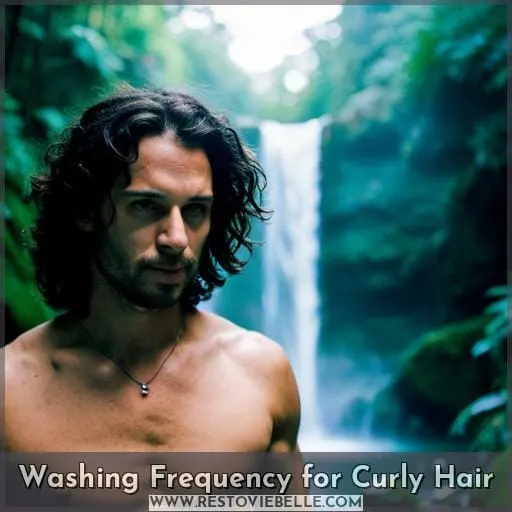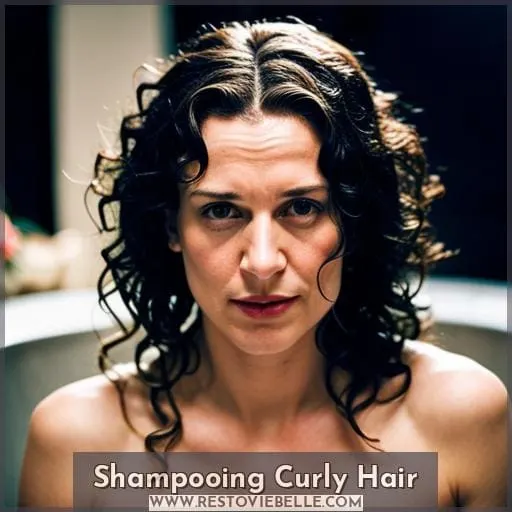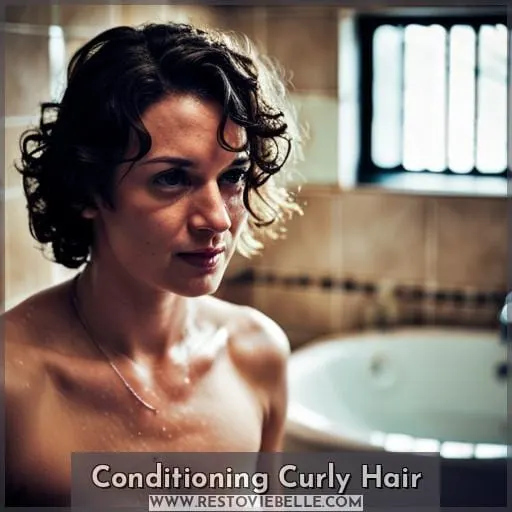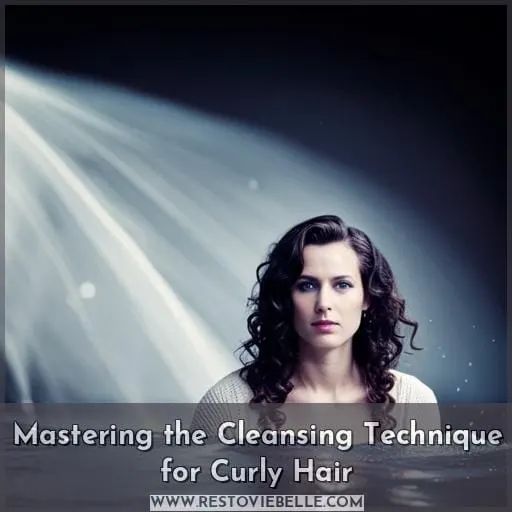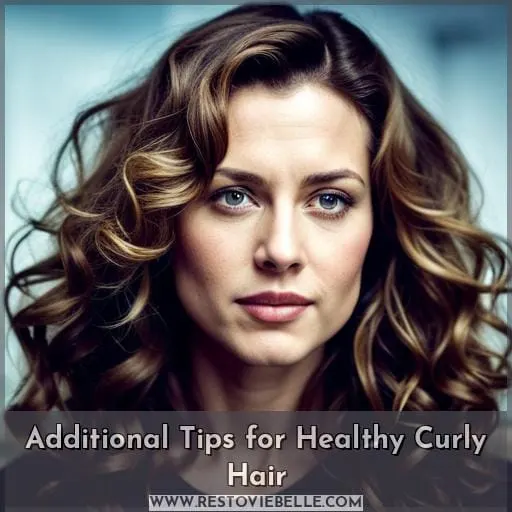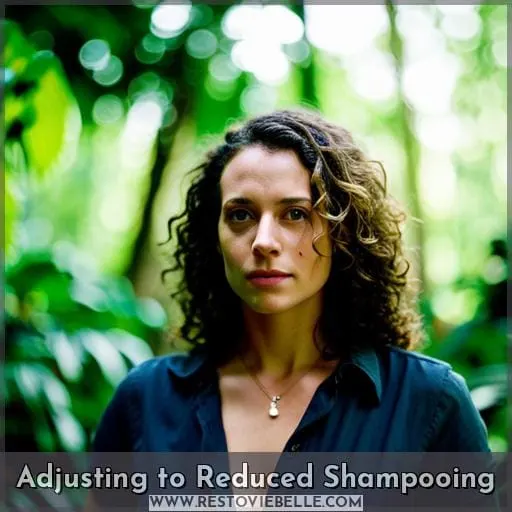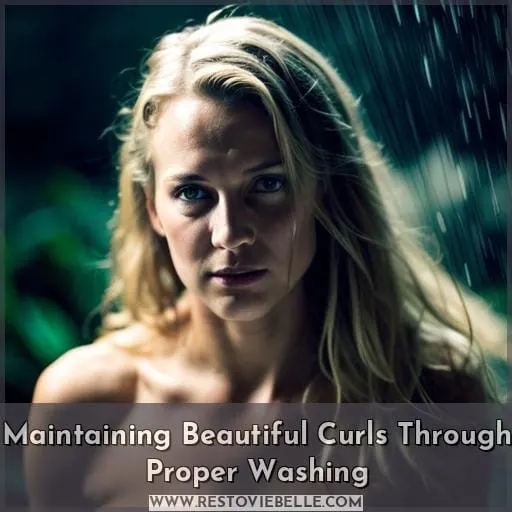This site is supported by our readers. We may earn a commission, at no cost to you, if you purchase through links.
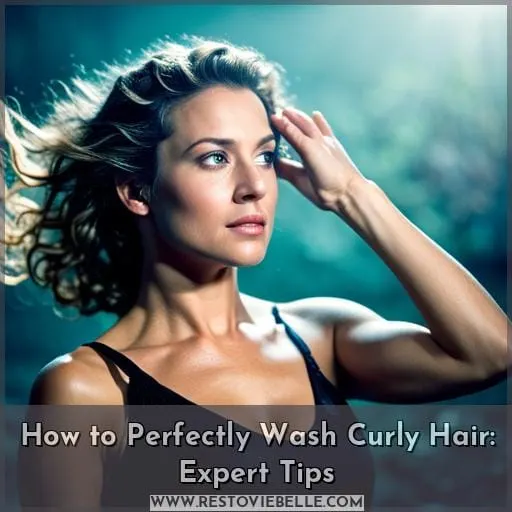 Do you want to know how to wash curly hair properly? If so, then this article is for you. Whether your curls are tight or loose, all types of textured locks need special care in order to stay healthy and strong.
Do you want to know how to wash curly hair properly? If so, then this article is for you. Whether your curls are tight or loose, all types of textured locks need special care in order to stay healthy and strong.
To ensure that your locks remain hydrated and look their best, it’s essential that you master the techniques of washing curly hair correctly.
Table Of Contents
- Key Takeaways
- Washing Frequency for Curly Hair
- Shampooing Curly Hair
- Conditioning Curly Hair
- Mastering the Cleansing Technique for Curly Hair
- Additional Tips for Healthy Curly Hair
- Adjusting to Reduced Shampooing
- Scrubbing the Scalp With Silicone-Free Conditioner
- Maintaining Beautiful Curls Through Proper Washing
- Conclusion
Key Takeaways
- Use sulfate-free shampoo for cleansing.
- Co-wash between wash days.
- Proper shampooing technique is important.
- Deep conditioning and moisturizing shampoo is essential.
Washing Frequency for Curly Hair
If you have curly hair, the frequency with which you wash it is essential for maintaining healthy locks! Weekly washing should suffice if your scalp is oily or heavily product-laden; heat styling requires less frequent upkeep, while drier hair can be washed monthly.
Don’t forget to shampoo when necessary – after exercise, swimming sessions, or when your curls feel dirty and itchy.
Weekly Washing for Heavy Products or Oily Scalp
If you’re using a lot of products or have an oily scalp, wash your hair once a week to keep it healthy and bouncy.
- Scalp massage techniques: Massage the scalp while shampooing for added cleansing benefits.
- Clarifying treatments: Use sulfate-free shampoo to cleanse without stripping moisture from curls. Focus on the roots first, then mid-lengths and ends.
- Controlling excess oil: Avoid over-conditioning as it can lead to limp hair. Use lukewarm water for washing and a cool rinse afterwards.
- Preventing product buildup: Choose SLS-free shampoos with natural oils. Avoid alcohol-heavy products, which can cause breakage and crunchy curls.
- Product selection for oily scalps: Look for lightweight conditioners tailored specifically towards curly/oily hair types. Weekly treatments are ideal!
With regular maintenance, you’ll be able to achieve beautiful, bouncy curls that will last all week long!
Less Frequent Washing for Heat Styling
For heat styling, try washing your hair twice a month to keep curls looking their best. Reduced heat exposure helps protect delicate strands and minimize damage. Take extra care when applying styling products – avoid alcohol-heavy formulas that can cause crunchy locks! Use curl pattern-specific conditioners and moisturizing stylers to retain moisture without stripping away natural oils.
Monthly Washing for Drier Hair
Drier hair requires washing only once a month to keep curls healthy and bouncy. Consider using a moisturizing shampoo for extra hydration, followed by deep conditioning treatments and scalp exfoliation methods.
Incorporate anti-frizz solutions like leave-in conditioner, overnight care products, or hydrating masks to prevent breakage and create softness in your locks. Additionally, make sure you massage the scalp when cleansing as this helps remove any buildup on the strands while promoting cleanliness at the same time.
Washing When Necessary (Dirty, Itchy, After Exercise)
When you’re feeling itchy, sweaty, or in need of a post-workout refresh, don’t hesitate to cleanse your curls. Opt for sulfate-free shampoos with natural oils when washing after exercise, swimming, or when a dirty and itchy scalp occurs.
Gently detangle your hair using your fingers while the shampoo is in your hair, instead of using a wide-tooth comb. Make sure to massage your scalp well to remove buildup, but be careful not to over-condition, as it can lead to limpness.
To maintain moisture balance without disrupting your curl pattern, consider co-washing between wash days. When applying conditioner products, focus on the mid-lengths down through the ends, avoiding the scalp area.
Afterward, dry your hair gently with a cotton t-shirt before bedtime. Additionally, follow up with weekly treatments adjusted based on porosity levels to achieve healthier and bouncier curls.
Shampooing Curly Hair
It’s important to understand the basics of shampooing curly hair. Using a sulfate-free shampoo is essential for avoiding overly dry or brittle curls, while selecting one that meets your hair type and needs will help you achieve desired results.
Additionally, proper technique, like using lukewarm water during rinsing, helps promote healthy, bouncy curls.
Importance of Using Sulfate-Free Shampoo
You can keep your curls looking their best by using sulfate-free shampoo to gently cleanse and nourish them! Benefits include frizz prevention, maintaining curls, and proper curly hair washing. Alternatives are SLS-free shampoos with natural oils or a cleansing technique. Avoid products with ingredients like silicones that build up on the hair.
Selecting the Right Shampoo for Your Hair
Choose the best shampoo for your curls – one that caters to your hair’s specific needs! Look closely at ingredients and avoid sulfates, which can strip away natural oils. Consider scalp health when selecting a low-lather shampoo. Ask yourself if there’s a risk of allergic reactions or other sensitivities with certain products.
Clarifying shampoos are great for deep cleansing but should only be used occasionally as they may also strip moisture from hair strands easily.
Keep track of how different curly hair products affect your washing routine and adjust accordingly.
Proper Shampooing Technique
Massage your scalp and rinse thoroughly when shampooing to cleanse without stripping, anachronistically speaking. Choose a mild sulfate-free formula for pH balancing and avoid foam-free cleansers. Detangle with fingers or a wide-tooth comb while massaging the scalp for optimal cleansing benefits.
Use lukewarm water, but finish with cool water to seal in moisture after shampooing according to this method.
Rinsing With Lukewarm Water
Rinse your curls with lukewarm water to prevent drying them out. Lukewarm water helps preserve the hair’s natural hydration and is less likely to disrupt curl definition compared to hot water.
A cool rinse at the end of washing can also help seal in moisture while preventing product buildup on strands. For those with drier hair types, opting for a lukewarm wash may be beneficial as it still provides cleansing without stripping away too much oil from the scalp or strands.
To maximize benefits and minimize damage, follow up shampooing by conditioning mid-lengths down before rinsing thoroughly for optimal results!
Conditioning Curly Hair
When caring for your curly hair, it’s important to apply a matching conditioner and use a leave-in conditioner. Pay special attention when drying the hair as over-conditioning can lead to limp curls.
Applying Matching Conditioner
After shampooing, follow up with a matching conditioner and focus on the mid-lengths to ends for optimal nourishment. Use it to effectively enhance moisture, restore balance, and revive curls. Ensure proper application by detangling before applying the cleansing conditioner from mid-shaft down to the ends while avoiding the scalp area.
Deep conditioning treatments can help nourish curls further; use them 1–2 times per week depending on dryness levels or individual hair needs.
Use of Leave-in Conditioner
For extra moisture, manageability, and frizz control, try using a leave-in conditioner! When selecting one, look for certain ingredients, such as natural oils. Benefits include taming flyaways and helping curls keep their shape. You can also use it overnight for maximum hydration or with the cleansing technique to help detangle hair during the washing routine.
Generally, apply the leave-in conditioner from mid-shaft down after shampooing. However, use less than rinse-out conditioners when styling curly hair regularly to avoid limpness or over conditioning. The choice between leave-in and rinse-out products depends on your desired level of conditioning frequency.
Drying Hair With Care
Gently towel dry with a soft cotton t-shirt and let the curls delicately fall into place for a bouncy finish. Use gentle techniques like diffusing or air drying to keep frizz at bay. Microfiber towels can help absorb excess water, while plopping helps define your waves without creating too much tension on the strands.
Air drying is recommended over heat styling because it locks in moisture and adds shine! Curly hair products, such as leave-in conditioners, are great for detangling benefits and added hydration, leaving you with shiny, wavy hair that’s free from split ends or breakage.
With these tips, you’ll be able to achieve beautiful results every time – all while protecting your precious curls from damage!
Avoiding Over-Conditioning
When conditioning your curls, avoid using too much product to prevent limp hair. Balance moisture levels and prevent greasy residue by following optimal techniques such as choosing lightweight formulas, shampooing with lukewarm water, focusing the conditioner on mid-lengths to ends only, and avoiding overconditioning.
Utilize a detangling process while in the shower for frizz control and use leave-in conditioners for added smoothness.
Mastering the Cleansing Technique for Curly Hair
Ready to take your curly hair care routine up a notch? Mastering the cleansing technique is key.
Start by using lukewarm water and sulfate-free shampoo, focusing on your scalp to remove buildup without stripping away moisture. Use a small amount of product and gently massage it in with your fingertips while detangling at the same time.
Follow up with conditioner from mid-shaft down. Then, use towels or t-shirts instead of rubbing dry for frizz control.
Post wash, style wet locks with finger combing rather than brushing. If air drying isn’t an option, try using a diffuser attachment on a low heat setting as you blowdry.
Don’t forget weekly treatments too – they’re essential for all curl types! With these tips, you can unlock beautiful, bouncy curls that are nourished and ready to shine!
Additional Tips for Healthy Curly Hair
You’re on the right track for beautiful, healthy curls! To start your journey off strong, consider pre-pooing with a moisturizing shine oil before showering. Use a wide-tooth comb to distribute products evenly and opt for air drying instead of diffusing when possible.
Be sure to choose an SLS-free shampoo with natural oils and use towel drying techniques like plopping or microfiber towels to reduce frizz. When styling wet curls, use your fingers instead of brushes. Co-washing can also help maintain moisture, while leave-in conditioner offers an extra layer of smoothness and anti-frizz protection.
Finally, silicone-free products are essential since silicones build up on hair over time, leading to limp hair or breakage.
Pre-Poo for Added Moisture
Give your curls an extra boost of moisture with a pre-poo before showering! Pre-poo benefits include added hydration, reduced breakage from styling and washes, and added shine.
Here are some application tips:
- Section your hair into four parts.
- Apply the oil in sections, massaging gently.
- Comb through evenly.
The frequency of pre-pooing depends on your hair type, but once every two weeks is ideal. Overuse can lead to product buildup, resulting in scalp irritation and dryness instead of the desired moisture balance.
If you don’t want to take the time to apply oils, an alternative is to use a cream-based leave-in conditioner. It will provide similar benefits without the messiness associated with pre-pooing.
Using Wide-Tooth Comb
To keep your curls looking their best, use a wide-tooth comb to distribute products when styling. According to the American Academy of Dermatology, it’s up to six times more gentle on wet hair than a regular brush.
When washing curly hair, start detangling with fingers before using the comb. Make sure you select a comb that is designed for delicate strands.
During conditioning, use non-tackifying conditioners. They are much more comb-friendly and easier to spread through damp locks without snagging or tangling.
With these tips in mind, you can achieve beautiful, healthy curls every time!
Air Drying Vs. Diffuser
Compare air drying and using a diffuser to achieve bouncy, healthy curls – the choice is yours! Whether you’re looking for pros and cons of each method or best practices for styling curly hair, there’s something out there for everyone.
Here are five tips:
- Use a lightweight product on damp hair before air drying.
- If you opt to use a diffuser, make sure your setting isn’t too hot or it may dry out your curls.
- Consider investing in curly-hair specific products with natural oils; avoid alcohol-heavy products that can cause breakage.
- For an extra boost of moisture after washing, apply pre-poo oil like Curl Moisturizing Shine Oil prior to showering.
- Towel drying with plopping techniques helps reduce frizz when using either technique.
Lastly, don’t forget about extensions care if you wear them – they should be dried separately in order to maintain their shape! So embrace the power behind knowing which drying methods work best for your locks: choose wisely between air dry vs diffusion so that you can enjoy beautiful volume all day long!
Choosing the Right Hair Products
Investigate the right hair products for your curl type to achieve healthy, bouncy curls. Know what ingredients provide moisture and which ones can weigh down curls. Pick sulfate-free shampoo as it cleanses without stripping away natural oils.
Conditioner should focus on mid-lengths to ends. Use a lightweight pre-shampoo treatment such as oil for added moisture before showering. Distribute evenly with a wide tooth comb, then rinse thoroughly and towel dry using microfiber towels or the plopping technique.
Avoid alcohol-heavy products that can cause breakage, silicones that build up in curly hair, and overconditioning leading to limpness and frizziness.
Towel Drying Techniques
Try using a soft cotton T-shirt or microfiber towel to gently dry your hair and reduce frizz. When it comes to drying curly hair, consider the texture of your locks as well as the type of material you use for best results.
Here are five key tips:
- Microfiber towels help absorb more water than cotton.
- Plopping is an effective method that helps define curls.
- Air drying should be preferred over blowdrying whenever possible.
- Frizz prevention products can be used with gentle patting when damp and avoid using brushes on dry curls.
- Hair texture consideration ensures proper moisture balance without stripping away natural oils.
Get creative with these techniques to find what works best for you!
Styling Wet Curls Properly
To style wet curls properly, finger-comb your hair with a lightweight conditioner and use a diffuser attachment on your hairdryer to maintain their bouncy shape.
Wet styling is key for enhancing curl definition and longevity. Avoid brushing dry curls as it can cause frizz or breakage.
When using setting techniques like plopping or microfiber towels, make sure to keep them loose so the curls don’t become tight.
For added smoothness and frizz control, consider applying leave-in conditioners that are free of alcohols and silicones, which can damage wet hair care routines over time.
With the right wash routine tailored to each individual’s unique needs, anyone can achieve healthy, beautiful curl enhancement!
Co-Washing and Leave-in Conditioner
Consider co-washing and using a leave-in conditioner for added smoothness and frizz control to keep your curls healthy.
Co-washing is an alternative way of washing curly hair that doesn’t require traditional shampooing.
A leave-in conditioner can also be used to enhance moisture while controlling flyaways.
Benefits of this method include keeping natural oils intact while avoiding harsh ingredients like sulfates or alcohols found in shampoos.
When compared to traditional methods, co-washing requires less frequent cleansing.
Silicone-Free Products
Swap out silicone-heavy products for ones that are SLS-free and full of natural oils to keep your curls healthy and hydrated. Benefits include reducing frizz, managing tangles naturally, avoiding product buildup, and maintaining hair’s elasticity.
Finding alternatives is easy – research ingredients on each label or seek independent advice from trusted sources. Understanding what’s in a product can help you find the right balance for softness without sacrificing definition or bounce.
Try styling with an alcohol-free mousse to gain hold without drying curly hair out further! Use microfiber towels instead of regular cotton towels when drying off wet strands too!
For maximum benefits, try replacing all silicone products with natural options – your curls will thank you!
Adjusting to Reduced Shampooing
If you’re looking to reduce shampooing, your hair may need some time to adjust. Start with a scalp scrub using silicone-free conditioner or pre-poo treatment like Curl Moisturizing Shine Oil before showering.
During the transition, use refreshing techniques such as co-washing and leave-in conditioners for extra moisture control. A sulfate-free shampoo is also key when choosing cleansing alternatives. Focus it on your scalp rather than directly onto the hair itself while massaging gently with fingers during the detangling process.
Dry curls can be achieved by air drying or using a diffuser attachment on a hairdryer for quick results without disrupting curls.
With these tips and tricks, you’ll find that reducing shampoo usage improves both styling flexibility and the overall health of your curly locks over time!
Scrubbing the Scalp With Silicone-Free Conditioner
To achieve soft, bouncy curls, try scrubbing your scalp with a silicone-free conditioner to avoid an oily look – as if it were a soothing massage! This method of hair washing offers the following benefits:
- Scalp massage can improve circulation and oxygenation for healthier hair growth.
- Silicone-free products are gentler on delicate strands and won’t strip away natural oils that keep curly locks hydrated and healthy-looking.
- Conditioning the scalp while cleansing helps restore moisture levels in dry or damaged hair without having to use shampoo every time you wash your tresses.
- Cleansing without using shampoo is great for those who have sensitive skin or allergies since SLS-free formulas don’t contain harsh chemicals that irritate scalps easily.
- Massaging in product when cleaning encourages even distribution so each strand gets its fair share of nourishment, leaving behind softer, more manageable curls post-shower session!
Use this technique regularly as part of an ongoing routine for optimal results; be sure to follow up with leave-in conditioners after drying off too!
Maintaining Beautiful Curls Through Proper Washing
You can maintain beautiful curls through a washing routine that caters to your specific hair type and needs. Start by considering the right frequency for your individual needs – once a week, twice a month, or even once a month based on product use, oiliness, and texture of hair.
Use sulfate-free shampoo to cleanse without stripping, and use lukewarm water followed by a cool rinse. Apply conditioner from mid-shaft down to ends, avoiding the scalp area. To prevent frizz, consider applying a pre-poo beforehand or using leave-in conditioner after washing for humidity protection.
Detangle with your fingers while the shampoo is still in, before rinsing off thoroughly. Then, dry your hair with a soft cotton T-shirt instead of a towel. When styling wet hair, use a wide-tooth comb only if necessary, especially at night when going to bed.
Conclusion
It’s time to embrace your curly hair and maintain healthy, beautiful curls through proper washing! Washing frequency depends on your hair type, product use, and oiliness. Utilizing sulfate-free shampoo, lukewarm water, and appropriate conditioner is key.
Additionally, using the right hair products, towel drying techniques, and styling wet curls properly will help you achieve the best results. Don’t forget to invest in pre-poo, leave-in conditioners, and silicone-free products to keep your curls looking their best.
